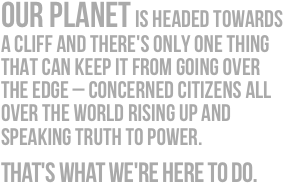by Graham Reeder
So how are climate change and health connected anyway? I don’t know about you, but the first thing that comes to mind when I used to think about climate change is arctic sea ice and major industry polluting. As I’ve developed a stronger interest in public health issues over the last couple of years, the human ecologist in me has driven me to make connections between climate change, social justice, and health. And guess what…I’m not alone. The wonderful thing about COPs is that if you’re passionate about an issue that relates to climate change in any way, you’ll probably find a group of people here who engage in it as well.
This year’s COP has actually been a big one for climate and health; Sunday saw a whole side conference on health and climate change and there have been many side-events and meetings about making that link. Unfortunately, my work following the adaptation negotiations has meant that I haven’t been able to go to most of those things, but I’ve had a number of great conversations with some of the people working on the issues.
Climate change has major impacts on health issues which vary from region to region. One helpful way to categorise our thinking about this is to think about extreme weather events and slow-onset events. Extreme weather events are things like hurricanes, floods, heat waves and drought, all of which are linked to climate change (See IPCC fourth assessment report working group II). What most of these events do is exacerbate existing health problems; when disaster strikes, it is consistently the least resilient who suffer most. This is because they have less access to preventative health care, emergency services, can be already suffering from some other under treated health issue, or are literally living in more dangerous locations (low-lying areas, along eroding coastlines, in urban hot-spots, etc…) All of these conditions make extreme weather events a serious concern for health. This is not to say that only the poorer countries of the world are affected, I don’t think I have to remind anyone that the heat-waves in Europe and Hurricane Katrina were a perfectly good reminder that inequality in resilience and access to services is ever-present in even the richest nations.
In terms of slow-onset events, media and international attention has a tougher time picking up the story. One might call it easy to gain wide readership of a front-page story about floods in Bangladesh that have killed thousands and cost up to 20 million USD over the last two years, but in a world where attention span is adjusted to twitter and everything is urgent, it can be much more difficult to expose the impacts of changing vectors on malaria patterns in sub-Saharan Africa or glacial melting causing water-access issues in Latin America, and of course the looming sea level rise issue that has low-level urban areas quivering in their boots. These long-term impacts will have catastrophic impacts on health unless serious work is undertaken pre-emptively to build resilience and strengthen communities’ ability to cope. I say cope because given what I’ve seen from the UN on adaptation policy progress, coping is the best we can hope for. Some other climate related slow-onset events that are going to have major health impacts are ocean acidification, desertification, changes in salt-water/freshwater distribution, loss of traditional medicinal species, a major decrease in agricultural productivity, forest degradation, erosion due to changing rainfall, and mass migration due to environments becoming uninhabitable. I’ll touch on the migration piece in a future blog post, but all of these impacts have colossal health ramifications that most of the world’s infrastructures are completely unprepared to deal with. We have wasted so much time fighting about whether or not climate change is real and who should do something about it that it is coming around to knock us over from behind.
In short, the connection between climate change and health is a crucial one. Given the current ambition levels on the table and the likelihood of anything changing soon, it looks like we’re in for a whole lot of warming, and a proactive health/resilience centered approach is the only chance of dealing with this kind of catastrophe.
On a policy note, the most recent AWG-LCA (Ad-hoc Working Group on Long-term Cooperative Action) text has an addendum with, among other things, sections on building resilience; poverty and inequality; protecting and promoting human health; gender; territory, mobility, and urban development; and migrants. Most of the text in these sections involves looking into things and further investigating them rather than acting on the knowledge that is already there, but seeing this language in a text like this is a little bit refreshing. There is supposedly a new text coming out tonight or tomorrow, only time will tell if any of those sections remain.


